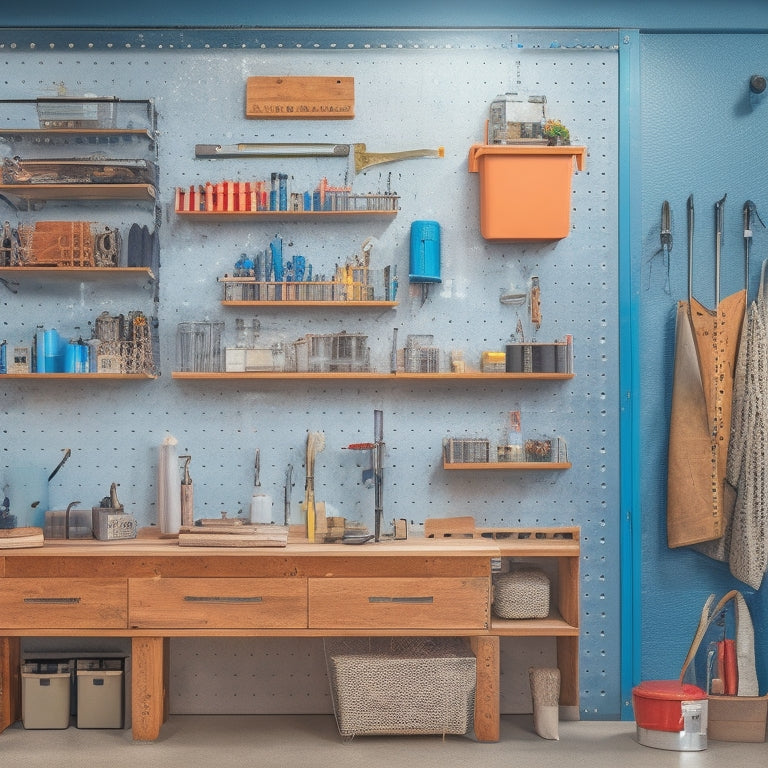
10 Essential Storage Hacks for Small Workshops
Share
You can release your small workshop's full potential by implementing essential storage hacks. Start by maximizing vertical space with wall-mounted shelving, slatwall panels, and pegboards. Utilize wall-mounted shelves to store heavy items and free up floor space. Optimize your toolbox organization by dividing tools into logical sections and using toolbox dividers. Label and categorize tools by function, frequency of use, or project type. Install sliding storage bins, create a pegboard station, and store small items in baskets. Designate a cord station to keep cords and cables organized. By implementing these hacks, you'll be well on your way to a more efficient and clutter-free workshop, and there's even more you can do to take it to the next level.
Key Takeaways
• Install wall-mounted shelving, slatwall panels, or pegboards to maximize vertical storage space and optimize the workshop's layout.
• Utilize toolbox dividers, pegboard hooks, and magnetic tool holders to categorize and store tools efficiently, reducing clutter and improving productivity.
• Implement a labeling and categorization system for tools, using pegboard organization, bins, and baskets to ensure easy access and identification.
• Hang bikes and accessories using bike lift options, hooks, and wall-mounted folding racks to free up floor space and create a more organized workshop.
• Designate a cord station with hooks, bins, or reels to store cords, cables, and hoses, keeping them organized, labeled, and easily accessible.
Maximize Vertical Storage Space
By installing wall-mounted shelving, slatwall panels, or pegboards, you can effectively maximize your workshop's vertical storage space, keeping frequently used tools and materials within easy reach while freeing up valuable floor space. This strategic storage approach allows you to make the most of your workshop's ceiling height, ensuring that every inch counts.
Consider utilizing ceiling hooks for ladder storage, keeping them securely out of the way yet easily accessible when needed.
Additionally, vertical tool racks and pulley systems can be installed to store long-handled tools, such as brooms and extension poles. These systems enable you to easily lift and lower tools, reducing strain on your back and shoulders.
By optimizing your workshop's vertical space, you'll be able to efficiently store more items, reducing clutter and increasing productivity. With a well-organized workshop, you'll be better equipped to serve others, whether it's fixing a neighbor's bike or building a community project.
Utilize Wall-Mounted Shelves
When you utilize wall-mounted shelves in your small workshop, you're making the most of your vertical space, which is especially important in cramped areas.
By installing shelves that go up to the ceiling, you'll be able to store heavy items like power tools and machinery, keeping them off the floor and out of the way.
This won't only free up floor space but also reduce clutter and make your workshop a more efficient and safer working environment.
Maximize Vertical Space
You can significantly expand your storage capacity by installing wall-mounted shelves that leverage the often-unused vertical space in your small workshop. This vertical organization strategy is a game-changer for small workshop tips, as it allows you to store more items without occupying valuable floor space. By maximizing your vertical space, you can create space-saving storage solutions that keep your workshop organized and clutter-free.
Here are some tips to help you get the most out of your wall-mounted shelves:
-
Choose adjustable shelves that can be moved up or down to accommodate items of different sizes.
-
Opt for deep shelves to store bulky items like power tools or equipment.
-
Install shelves near frequently used areas to reduce walking distances and increase efficiency.
- Label each shelf to make sure you can quickly find what you need, even when stored out of sight.
Store Heavy Items
How do you safely store heavy items like machinery, equipment, and tools in your small workshop without taking up valuable floor space? The answer lies in utilizing wall-mounted shelves, a clever storage hack that optimizes your workshop's vertical space while making sure weight distribution is evenly managed.
By installing sturdy shelves on your walls, you can store heavy equipment, machinery, and tools, freeing up floor space for more important tasks.
When selecting wall-mounted shelves, consider the weight capacity of each shelf and the overall weight distribution of the items you plan to store. It's vital to distribute the weight evenly across the shelves to prevent collapse or strain on the walls. Look for shelves with reinforced brackets and sturdy construction to make sure they can support the weight of your equipment and tools.
Proper equipment storage is essential in a small workshop, and wall-mounted shelves provide a practical solution. By implementing this storage hack, you'll create a safer, more organized, and efficient workspace that allows you to focus on serving others with precision and care.
Optimize Toolbox Organization
Optimize Toolbox Organization
Organizing your toolbox into logical sections and assigning a designated home for each item saves time and reduces frustration by minimizing searches for misplaced tools. This enables you to focus on the task at hand, rather than wasting time searching for that one specific tool.
To take your toolbox organization to the next level, consider the following strategies:
-
Divide and Conquer: Use toolbox dividers to separate tools into categories, making it easier to find what you need quickly.
-
Hang It Up: Install pegboard hooks to hang tools like hammers, saws, and levels, keeping them within easy reach.
-
Magnetic Power: Utilize magnetic tool holders to store small metal tools, such as wrenches and pliers, on metal surfaces.
- Bin It: Use parts bins to store small parts and fasteners, keeping them organized and easily accessible.
Label and Categorize Tools
When you're working in a small workshop, having a system in place to quickly locate the tools you need is crucial.
By implementing a tool organization system, you'll save time and reduce frustration.
Now, let's explore how to create effective tool category labels that will help you get the most out of your system.
Tool Organization Systems
You'll likely find that categorizing tools by function, frequency of use, or project type is an effective way to establish a logical tool organization system. This approach helps make certain that your most frequently used tools are easily accessible and that similar tools are stored together. For instance, you can group all your woodworking tools in one area and your automotive tools in another.
When it comes to tool organization systems, consider the following:
-
Pegboard organization: Install pegboards on your workshop walls and hang tools like hammers, screwdrivers, and pliers.
-
Tool storage solutions: Use bins, baskets, and containers to store small tools and accessories, keeping them organized and out of the way.
-
Garage storage ideas: Utilize ceiling-mounted storage racks for infrequently used tools and materials, freeing up floor space.
- DIY workshop storage: Repurpose old furniture or crates to create custom storage solutions that fit your unique needs.
Tool Category Labels
By categorizing tools into logical groups and labeling each category, you can quickly identify where a specific tool is stored and reduce time spent searching for it. This is especially important in small workshops where space is limited and every minute counts. To get started, group tools by function, such as drilling, cutting, or measuring. Within each group, further categorize tools by type, like cordless drills or circular saws. Use clear and concise labeling techniques, such as color-coding or alphabetical ordering, to make it easy to spot the tool you need.
Proper tool categorization and labeling also facilitate tool maintenance, as you can easily locate tools that need servicing or replacement. This, in turn, contributes to better workshop organization and more efficient storage solutions. By implementing a logical labeling system, you'll save time, reduce frustration, and increase productivity.
Additionally, a well-organized workshop promotes a safer working environment, as tools are less likely to be misplaced or damaged. By investing a little time in tool categorization and labeling, you'll reap significant benefits in the long run.
Install Sliding Storage Bins
Maximize your workshop's floor space and simplify inventory management by installing sliding storage bins that can be easily accessed and rearranged as needed. This sliding storage solution is a space-saving option that will revolutionize your workshop's organization and efficiency.
Here are some key benefits to contemplate:
-
Easy access: Sliding bins allow you to quickly retrieve the items you need without having to dig through cluttered shelves or cabinets.
-
Flexibility: You can rearrange the bins as needed to accommodate changing inventory or project requirements.
-
Space optimization: Sliding bins make the most of your workshop's floor space, keeping frequently used items within easy reach.
- Visual organization: Labeling the bins helps you quickly identify what's inside, making it easier to maintain a clutter-free workshop.
Hang Bikes and Accessories
As you work to optimize your small workshop's storage, you'll want to contemplate hanging your bikes and accessories to free up valuable floor space.
You'll need to determine the right bike lift options for your needs, strategically place hooks to maximize storage, and develop a system for organizing accessories like helmets and gloves.
Bike Lift Options
You can reclaim valuable floor space in your small workshop by installing a bike lift that allows you to hang your bikes and accessories from the ceiling. This is especially useful if you have limited room to spare.
A ceiling hoist with a pulley system is a great option, as it provides easy lifting and lowering of your bikes. Alternatively, you can opt for wall-mounted racks, which offer a more permanent storage solution.
Here are some bike lift options to contemplate:
-
Ceiling-mounted bike lifts: These are ideal for high-ceilinged workshops and can be adjusted to fit different bike sizes.
-
Wall-mounted folding racks: These are perfect for smaller workshops and can be folded up when not in use.
-
Pulley system bike lifts: These provide a smooth and easy way to lift and lower your bikes.
- Hybrid storage solutions: These combine wall-mounted racks with ceiling-mounted storage, offering maximum storage capacity.
Hook Placement Tips
Once you've chosen a bike lift option, it's time to strategically place hooks to hang bikes and accessories, ensuring efficient use of your workshop's ceiling space. Consider the types of items you need to store and the frequency of use.
For hook organization, group similar items together, such as all bike helmets or tools. Install hooks at varying heights to accommodate different sizes and types of items. This will create space-saving solutions and make the most of your workshop's vertical space.
Get creative with your hook displays by incorporating DIY hook projects. Use repurposed materials like old pallets or wooden crates to create unique and functional hooks. You can also add labels or signs to identify what's stored on each hook, making it easier to find what you need quickly.
Accessory Organization
By categorizing and grouping accessories like bike seats, handlebars, and wheels, you'll be able to efficiently hang and store them, freeing up valuable floor space in your workshop. This allows you to focus on other important tasks and projects.
When it comes to accessory organization, maximizing your wall space and thinking vertically is crucial. Here are some functional and stylish organization ideas to get you started:
-
Install a pegboard: Hang frequently used accessories like bike lights, locks, and tools within easy reach.
-
Use wall-mounted bike hooks: Hang your bikes from the ceiling or wall, keeping them organized and out of the way.
-
Invest in a storage rack: Store wheels, tires, and other bulky accessories in a compact and accessible manner.
- Create an accessory display: Showcase your favorite cycling gear and accessories on a stylish display rack, adding a touch of personality to your workshop.
Create a Pegboard Station
A pegboard station can be customized to your specific needs, featuring a personalized layout of hooks, bins, and accessories that maximize storage capacity and efficiency in your small workshop.
You can create a pegboard customization that suits your workflow by selecting the right combination of hooks, bins, and accessories. This will allow you to store frequently used tools and materials within easy reach, saving you time and effort.
For hanging tool storage, consider using hooks of varying sizes to accommodate different tools and accessories. You can also add bins and containers to store small parts, nuts, and bolts. Label each hook and bin to make sure you can quickly identify what's stored there. This will help you maintain organization and reduce clutter.
Additionally, consider adding a pegboard with a built-in shelf or cabinet to store larger items or infrequently used tools. By creating a well-organized pegboard station, you'll be able to work more efficiently and effectively in your small workshop.
Store Small Items in Baskets
You can utilize baskets of varying sizes to store small items like screws, nails, and other fasteners, keeping them organized and out of the way in your small workshop. This basket organization system allows you to maximize your storage space and reduce clutter. By storing small items in labeled baskets, you can easily find what you need when you need it, saving you time and increasing your productivity.
Here are some benefits of using baskets for small item storage:
-
Easy access: Baskets keep small items within easy reach, making it simple to grab what you need quickly.
-
Reduced clutter: By storing small items in baskets, you can keep your workshop surfaces clear of clutter and mess.
-
Improved visibility: Labeling your baskets helps you quickly identify what's inside, so you can find what you need at a glance.
- Customizable storage: Use baskets of different sizes to store items of varying sizes, from tiny screws to larger fasteners.
Designate a Cord Station
In a small workshop where cord clutter can quickly get out of hand, designate a specific area as a cord station to keep cords, cables, and hoses organized and untangled. This cord station will be your go-to spot for storing and managing all your cords, cables, and hoses, keeping them from getting tangled or lost.
You can install hooks, bins, or reels to store your cords, and label them for easy identification. This cable management system will save you time and frustration when searching for a specific cord or cable.
Consider using cord organizers or cable ties to keep your cords wrapped and tidy. You can also use a cord reel to store longer cords and hoses.
By designating a cord station, you'll be able to find what you need quickly and easily, making your workshop more efficient and productive. This workshop solution will also help reduce clutter and keep your workspace organized, giving you more room to focus on your projects.
Implement a Tool Cart System
By keeping cords and cables organized, you're now free to tackle another common workshop obstacle: tool clutter, which a well-implemented tool cart system can efficiently resolve. A tool cart system provides a centralized hub for your most frequently used tools, keeping them within easy reach and freeing up valuable workspace.
To get the most out of your tool cart, consider the following key features:
-
Customization: Choose a cart that can be tailored to your specific needs, with adjustable shelves and compartments to fit your unique toolset.
-
Tool cart accessories: Add accessories like tool holders, bins, and trays to maximize storage capacity and keep small items organized.
-
Tool cart organization: Designate specific areas of the cart for different tool categories, such as hand tools, power tools, and measuring instruments.
- Tool cart mobility: Opt for a cart with wheels or casters to guarantee easy movement around the workshop, allowing you to take your tools exactly where you need them.
Frequently Asked Questions
How Do I Prevent Rust on Metal Tools in Storage?
"Remember the time you spent hours restoring grandpa's rusty old toolbox? Don't let that happen again! You prevent rust on metal tools in storage by coating them with rust-inhibiting sprays or oils and storing them in a dry, climate-controlled space."
Can I Store Flammable Materials in My Workshop?
You shouldn't store flammable materials in your workshop unless you've confirmed proper ventilation and fire safety measures are in place, as even a small spark can ignite a devastating blaze, putting yourself and others at risk.
Are There Any Storage Solutions for Oversized Equipment?
You'll need customized storage solutions for oversized equipment; consider installing vertical shelving to maximize floor space or wall-mounted racks that securely hold bulky items, freeing up room for other essentials.
How Often Should I Clean and Maintain My Storage Systems?
As you dust off the cobwebs, remember that consistent upkeep is key. Set a maintenance schedule to clean your storage systems regularly, ideally every 2-3 months, to prevent clutter buildup and guarantee organization tips stay on track.
Are There Any Specific Safety Considerations for Workshop Storage?
When designing your storage systems, you'll want to prioritize safety precautions, ensuring proper ventilation to prevent hazardous fumes and dust accumulation, and securing heavy objects to prevent accidents and injuries.
Related Posts
-

What to Look for in a Pegboard Tool Storage Kit
When shopping for a pegboard tool storage kit, you need a system that combines customized organization, sturdy durabi...
-

Small Shelving Options for Tight Spaces
You're surrounded by tight spaces in your home, and you need clever shelving solutions that optimize storage without ...
-

What Size Rolling Storage Bin Do I Need
To determine the ideal size of your rolling storage bin, you'll need to measure your storage space accurately, consid...


